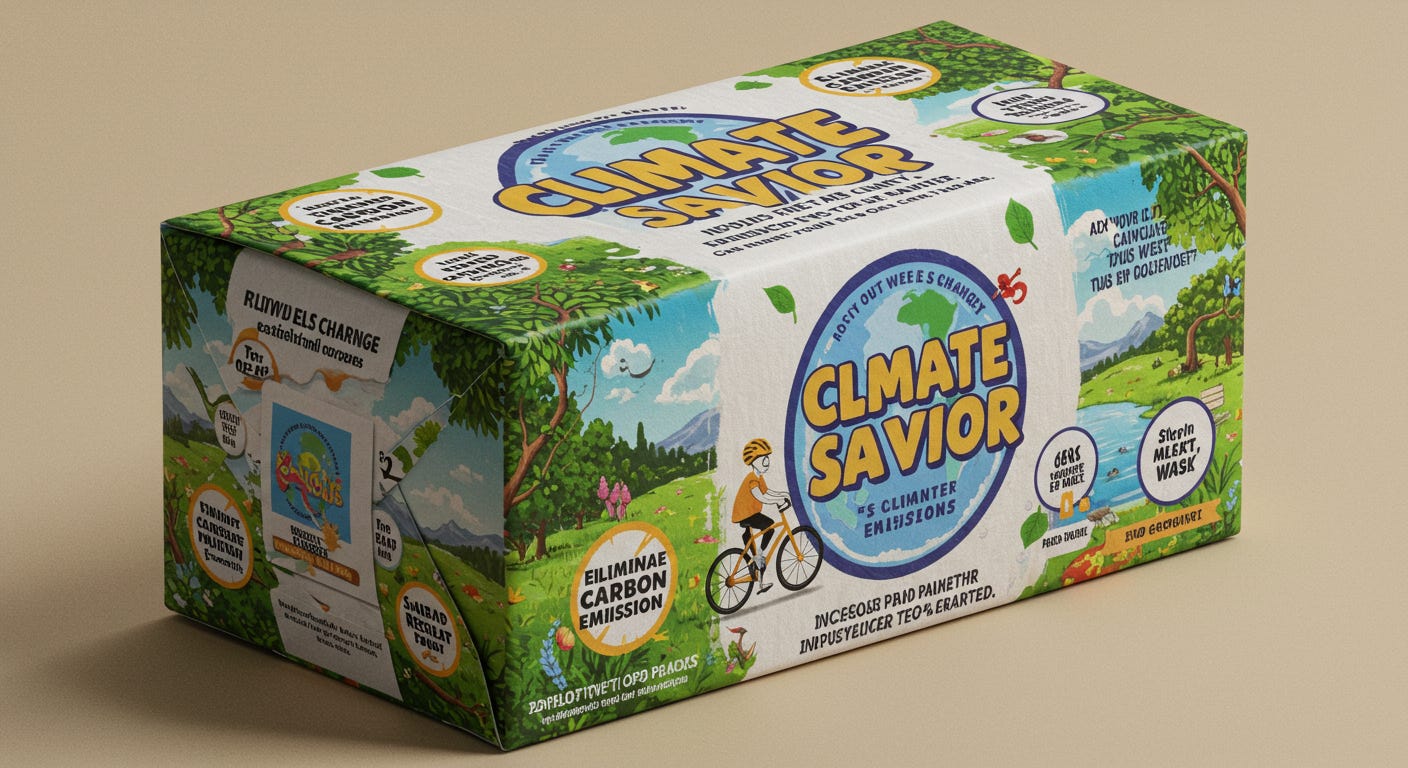Lies, Damn Lies, and “Climate Solutions”
A little rant on the most abused phrase in the climate world

Normally, when a phrase gets drained of all meaning through overuse, I don’t mourn it too hard. I don’t mind that “mission driven” or “game changing” have been rendered meaningless through droning repetition, because those phrases were corporate gobbledygook from the start. But I mind very much that “climate solution” gets slapped willy-nilly on just about anything that’s vaguely green, because we very much need climate solutions, and draining this phrase of semantic load impoverishes the way we talk about climate.
It’s a real problem. Talk to climate normies, and you quickly realize that when you say “climate solutions”, what they hear is “curbing greenhouse gas emissions.” A few better-informed normies might hear “tree-planting”, and even fewer might hear “direct air capture”.
Say “climate solutions”, and most people’s minds go to ideas that won’t solve anything.
At best, they’ll help us lose more slowly: delaying the onset of truly catastrophic climate by curbing the rate at which heat-trapping gasses accumulate in the atmosphere.
That’s not a solution. That’s a slower route to failure.
In 2025, “climate solution” must mean taking carbon dioxide out of the atmosphere tens of gigatons at a time.
And that’s tricky. Because while there are a million ways to take carbon dioxide out of the atmosphere, the hard part comes last — tens of gigatons at a time.
A gigaton is a billion tons. A thousand million tons. An insane amount of stuff.
Ten gigatons a year is, well, ten insane amounts of stuff.
Getting the order of magnitude right when you’re talking gigathis and terathats is always hard. Our brains aren’t wired for that many zeroes.
How much is ten billion tons, anyway?
Imagine all the weight of all the crude oil extracted worldwide over an entire year. Now double it. You’re still not quite at 10 gigatons.
Or add all the cement produced in a year, then double it, then add all the steel produced: you’re still 100 million tons short.
If your head is swimming now, that’s the point. It’s horribly uncomfortable to try to think at this scale. But we have to, because too much of our climate conversation happens at the wrong order of magnitude. Or, worse, without any awareness of orders of magnitude at all.
That’s how you end up with a point-missy climate discussion that goes nowhere. That’s how you end up celebrating removals in the scale of hundreds of thousands of tons, in a world where hundreds of thousands of tons is a rounding error.
Insisting on gigaton scale grounds the climate discussion in sanity. It disciplines it.
Because plenty of science fair-style ideas can capture carbon from the air…at around $1,000 dollars per ton. That would price a gigaton of carbon removal at a trillion dollars. Which is utter insanity. Madhouse gobbledygook. A non-starter.
What’s strange is that it’s now easier to finance removals that won’t scale than those that will. Microsoft and Google and Shopify and Stripe will pony up millions for impossible to scale projects. Which is why five hundred startups are off chasing those dollars, pursuing approaches that won’t solve anything other than corporate greenwashing needs. Far fewer startups are out chasing gigaton scale, because there’s no money there.
Much of what now passes for a climate removals industry consists in chasing these fundamentally unscalable efforts. Take “afforestation”: projects to convert existing cropland or savannas to forests. It sounds nice — it is nice. Who doesn’t like planting trees?
But is it a climate solution?
Well, let’s work it out. The most efficient afforestation projects need perhaps 400 square meters to capture a ton of carbon, about two tennis court’s worth.
To capture a kiloton, you’d need a thousand times more land, about 50 soccer fields’ worth. To capture a megaton, you need a thousand times more land than that — about the size of a small city. To capture a gigaton, you’d need a thousand times more land than that, almost twice the size of the UK.
To capture ten gigatons, you’d need to plant trees over four million square kilometers: about the land area of the EU. That’s more than a quarter of the arable land on the planet, but then if you turn a quarter of the farm land into forest, what are we going to eat? Even at the tiny scales that afforestation is done at now, it’s already igniting fierce land-grab controversies. Try to do this at global scale and you court a global, peasants’ revolt.
You can do similar sorts of back-of-the-envelope exercises for each of the bullshit “climate solutions” out there. When you’re through doing that, you’re going to end up where I ended up: obsessed with ocean fertilization.
Because ocean photosynthesis is the only climate solution that can come out of this sort of analysis still looking like an actual solution.
At some point, it clicked for me that 99.9% of climate solutions are bullshit: gestures at best, corporate greenwashing more often, but at any rate schemes with no conceivable path to 10-gigaton per year scale.
Which means every minute spent thinking about them is a minute wasted in the fight against climate change.


Now you are thinking like an engineer! Doing a feasibility down selection at the start is an important way to minimize wasted time.
We do need to build new stuff too, but that will take a lot longer. Nuclear needs to get cheaper to scale- when you burn dirt as fuel, it should be dirt cheap. I also like accelerated limestone weathering as it uses the ocean energy in a positive way without too much effort.
Words not present: "energy", "transition", "fossil", "renewable", "clean".
Am I missing something? It does not seem to be any percent brighter.